The Ultimate Ball Python Care Sheet For Beginners
Last updated: February 8, 2024

Summary
- Ball pythons are non-venomous snakes that are native to central and western Africa.
- They are carnivores and prey on rodents.
- Ball pythons are sexually dimorphic, with males growing up to 2 to 3 feet long and females growing up to 3 to 5 feet long.
- Ball pythons are generally good-natured and remain in a stationary position most of the time in their terrarium.
- They are solitary reptiles and prefer to stay away from the rest of the species.
- Ball pythons should be fed every 10-14 days as juveniles and every 1-2 weeks as adults. They should be fed frozen rodents that are slightly smaller than the widest part of their body.
Ball Pythons are quite popular snakes in the pet trade world due to their docile and friendly nature. These slithery creatures are the best choices for first-time pet owners, as they are tolerant and have slow movements. This makes them suitable for inexperienced owners to handle easily.
Native to the central and western African region, ball pythons thrive well in the warm tropical areas, forests, and semi-arid grasslands. Ball pythons or (python regius) are small in size and come in a wide array of patterns and colors.
In addition to being active and curious at night, these hunters are more active during dusk and dawn. Ball pythons, also known as Royal Pythons, are carnivores and hunt for prey like birds and rodents.
If you plan to adopt one to keep you company, go through our Ball Python Care Sheet to find out how to care for these creatures.
Do Ball Pythons Make Good Pets?

Pet owners who are new to adopting snakes and enthusiastic herpetoculturists on the search to include new species to their collection - will find ball pythons as great companions, but for those who have young children at home and are considering reptile pets that are child-friendly, be sure to explore various species to ensure the safety and enjoyment of all family members.
These reptiles are easy to care for, with a lifespan that ranges between 20 to 30 years in captivity. They do not need any special lighting or housing requirements and live mostly on a diet that includes rodents.
These non-venomous creatures are sexually dimorphic, where the males grow up to 2 to 3 feet (0.91 m) and females up to 3 to 5 feet (1.52 m) long. So, if you’re planning to get them home, make sure that you have sufficient space to house them comfortably. When it comes to the difficulty level of taking care of them, the Ball Python Care ranges between beginner to intermediate levels. Besides, they require low maintenance and are mostly found in excellent health conditions.
You May Also Like: Best Pet Snakes for Beginners
Do Ball Pythons Like To Be Held?
Once you bring your new ball python home, leave them alone in their new house to adjust for 1 to 2 weeks. Handling them immediately after traveling can create more stress and cause them to become a fussy eater. Once they start eating regularly, you can handle them by gently touching their back initially. Avoid startling them - as they are shy and prefer to go into hiding. Can you handle your ball python every day? Handle your pet around 1 to 2 times a week to tame them, as advised in our Ball Python Care Sheet.
Handling young juveniles and hatchlings can be quite challenging - as they need extra patience. At this stage of life, they are defensive and tend to strike at anything that comes their way. Though this may seem to be intimidating, eventually, they will learn to trust you. With gentleness and perseverance, once you establish trust with your ball python by handling them regularly - they become more used to human interaction over time.
Check Also: Best Reptile Pets For Handling
Is A Ball Python Dangerous?
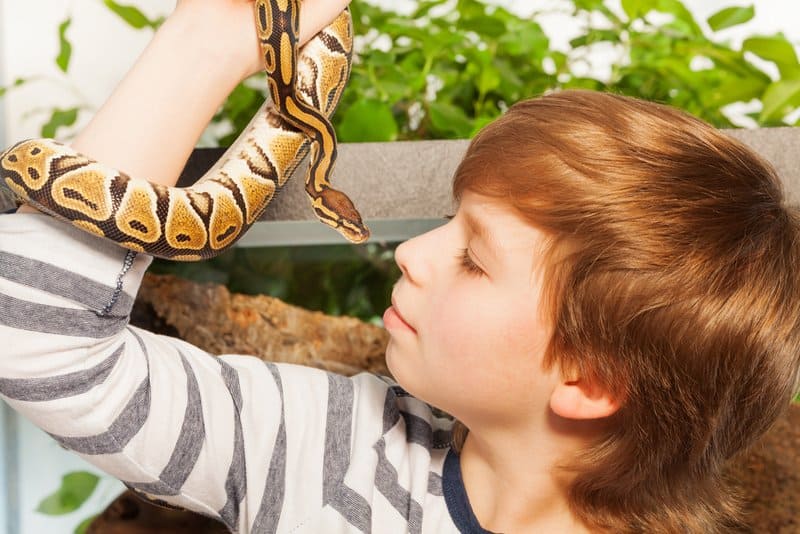
Of course not! Ball pythons are usually good-natured and remain in a stationary position most of the time in their terrarium. As they prefer to stay hidden, you will find them hiding inside boxes placed in their enclosure.
This solitary reptile displays a tendency to spend most of its life alone. Apart from breeding, they prefer to stay away from the rest of the species. It’s advisable to never house more than one ball python in the same cage to avoid fights. Even if you place a breeding pair in the same cage, be extra cautious and offer exceptional care even in such situations.
As part of their defensive mechanism, ball pythons usually coil up like a ball by placing their head in the middle. If they get startled or find you as a threat, they might bite you at some point. Do ball python bites hurt? Slightly, however, do not panic! Instead, wash the wound using soapy water and clean the area thoroughly.
What Supplies Are Needed To Care For A Ball Python?
Make sure to be fully prepared with all the necessities if you plan to get a new ball python home. What is needed to care for a ball python? To make things easier, we have put up a list of supplies you will need to take care of your new pet in our Ball Python Care Sheet.
- Appropriately sized front opening reptile tank like the Exo Terra tank with a mesh to secure the top. When it comes to juveniles and baby ball pythons, a 20-inch enclosure will work great.
- 22″ T5 HO D3 6% Forest UVB bulb.
- 90 to 100w halogen flood heat lights or emitters. Including a ceramic heat emitter, heat pad, heat mat or heat tape are also other options to maintain the heat inside the cage.
- 100 - 150 W basking spot bulb for a 40 L tank and 75w bulb for a smaller 20 L tank.
- Two plug-in lamp dimmers.
- 24″ T5 HO UVB single bulb light fixture or strip.
- Deep dome lamp fixture.
- Under tank heater placed beneath the basking spotlight. Avoid using heat rocks if you opt for the heat bulb or a heat lamp.
- Digital hygrometer and thermometer - Avoid placing them at the corners of the tank. You need to move them around to monitor the temperatures in different areas of the cage.
- Infrared thermometer.
- Large flat stone for basking.
- Temperature gun.
- Programmable digitized power strip with timer.
- Around 2 – 3 tight-fit caves or dry hides.
- Moist or humid hides for shedding time.
- Substrates like paper towels, shredded Aspen bedding, newspaper, and Sphagnum moss at the bottom of the tank.
- Decorative enrichment items like plants, flat rocks, cork logs, thick branches, and so on.
- Climbing decorations.
- Soft-tipped 12-inch feeding tongs or tweezers.
- Appropriately sized prey such as frozen rodents.
- Calcium and reptile multivitamins supplements.
- Heavy and large water bowl - huge enough to soak their body thoroughly.
- Water dish: It is important to place water in the ball python's enclosure at all times. Avoid using distilled water and opt for bottled water like spring water. Make sure the water does not contain any harmful chemicals like nitrates, ammonia, chlorine, etc. Instead, hydrate your new animals with water rich in electrolytes and essential ions.
- Ball Python Clean Up Pack.
- Ball Python Care Manual.
Remember to purchase all these things beforehand, before you get your snake. This will keep you stress-free and come as a huge favor for your new pet. To avoid panicking or making the wrong choice, it’s advisable to contact an experienced reptile breeder in your area.
Feeding Your Ball Python
A common question that a first-time reptile owner comes across: What should you feed a ball python? Go through our Ball Python Care Sheet to find out what these docile creatures survive on.
What Does A Ball Python Eat?
Ball pythons are nocturnal in habit and prefer to eat during the night. Like most snakes, they are carnivores and depend on meat for their sustenance. In the wild, they mostly strike and catch small mammals like rats, shrews, and birds.
While in captivity, to gain a spectrum of right nutrition, they need to consume animals as a whole. It’s advisable to offer a variety of prey items of different sizes. This includes:
- Small or medium-sized mice and rats.
- Quail chicks.
- Soft furry African rodents.
- Chicks.
Ball pythons may not be comfortable changing their feed constantly. Hence, you need to find out what exactly your constricting snake prefers. Juvenile ball pythons generally eat baby rodents like hoppers, pinkies, or fuzzies. Ball pythons feed on mice most of their lives. To increase their nutritional intake, it’s better to transition to rats as quickly as possible gradually.
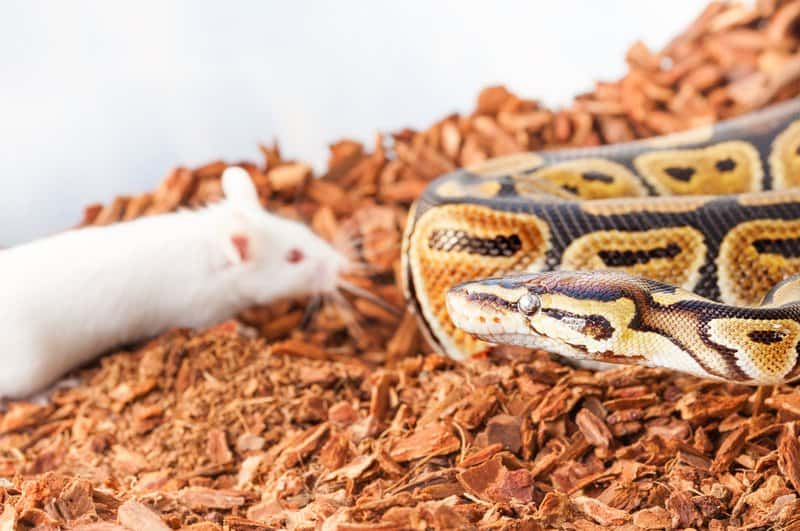
Frozen Prey (Recommended) Vs. Live Prey
Generally, frozen prey happens to be the optimal choice of feed when it comes to ball pythons. You can give your ball pythons frozen or thawed prey or even pre-killed rodents.
Frozen-thawed rodents are less costly and can be purchased in bulk. You can also store them easily when compared with the live portions. You can buy frozen preys in most pet stores and even online.
Avoid feeding live rodents to your newly acquired pet. As part of the defensive mechanism, live prey usually tends to attack by injuring or biting your snake. Ultimately, this can scare your snake and keep them from having their food. Besides, live rodents may have parasites living on their body, which will be transferred to your pet.
Never leave your snake unattended with a live rodent in the same enclosure for more than 10-15 minutes, as they can harm your pet and even cause fatal injuries leading to death.
How Often Should I Feed My Ball Python?
Being a carnivore, your pet snake needs meat for its survival. Young ball pythons must have their fill around once a week or once every 6 - 7 days to grow healthily. Adult ball pythons eat only once in a while and generally opt for adult rats and mice.
Based on the weight of your snake, their feeding pattern and the amount they consume varies.
- Ball pythons less than 200 g - feed on small mice once a week.
- Weighing between 200 and 350 g – opts for adult mice once in 7 to 10 days.
- Weighing between 350 and 500 g – eats weaned rat every 10 to 14 days.
- Weighing between 500 and 1500 g – Consumes small rats every 2 to 3 weeks.
- Weighing more than 1500g – prefers a medium rat once in 28 to 56 days.
Normally, they stay away from feeding during the winter season and the shedding period.
How Do I Know The Prey Size?
While selecting the right feed for your ball python, you need to consider the size of the prey. If it happens to be tiny, your pet may not thrive well due to a shortage of the right amount of nutrition. If the prey's size happens to be huge, your reptile may find it hard to ingest.
Here is a great video guide (22 minutes 52 seconds) from MJ's Pythons explaining the right size of food to give your ball python.
Always feed your reptile with prey that are smaller than the largest part of their body. For this, you need to measure the prey's circumference with the circumference of the widest body part of your pet snake. This will help them to digest their meal properly.
Most juveniles or baby ball pythons feed on baby rodents like hoppers or pinkies. These small rodents are quite inexpensive when it comes to the reptile diet.
Housing Your Ball Python
Like any other reptile, the enclosure set up for a ball python is crucial for their well-being and overall health. Before you bring one home, make sure that they have all the essentials needed in their habitat. Are ball pythons expensive to take care of? Read on to find out more!
Terrarium Size
There happens to be a misconception surrounding ball pythons that they prefer small, cramped, dark enclosures. This is not true! While choosing a ball Python habitat for your pet snake, make sure that they are large enough to house them comfortably.
Tiny cages will keep them from fully stretching their body, thereby promoting obesity which can impact the overall quality.
Based on the size of your pet reptile, the minimum dimension of their terrarium must be as follows:
- Baby snakes up to 300g – must be placed in a 10-gallon tub or enclosure with measurements of around 13” x 11” x 20”.
- Juvenile snakes up to 3” long – requires a 40-gallon Terrarium that measures around 18” x 36” x 18”.
- Subadults and matured adults beyond 3” longhouses well in a 130-gallon cage with measurements 24“ x 48“ x 24“ or even bigger.
Heating
Being cold-blooded reptiles, ball pythons require a wide range of temperatures within their habitat to regulate their body temperature. Heated areas in the enclosure will allow them to enhance their metabolism rate and promote healing and digestion quickly.
As for the cooler areas, they reduce the metabolic rate and improve energy conservation and rest. If the temperature is not right, you will notice your pet stays away from eating their meals.

The adequate temperature gradient for a ball python is a cooler end with 78 °F (ca. 26 °C) and a warmer end of 95 °F (ca. 35 °C). In their native habitat, they thrive well at an average temperature that ranges between 68 and 86 °F (ca. 30 °C), with an occasional hike off up to 96 °F (ca. 36 °C) or above.
Do ball pythons need heat at night? As ball pythons generally stay in burrows, they prefer a stable and cooler temperature. Hence, it’s advisable to maintain their terrarium with favorable temperature conditions.
- 72 to 80 °F (ca. 27 °C) – for the cooler hides.
- 86 to 90 °F (ca. 32 °C) – for the warmer hides.
- 95 to 104 °F (ca. 40 °C) – for the basking surface area.
- 72 to 78 °F (ca. 26 °C) – during the nighttime.
What Temperature Will Kill A Ball Python?
If the ambient temperature falls below 75 °F (ca. 24 °C) or goes beyond 93 °F (ca. 34 °C), it can turn fatal and cause serious burns to your ball python, including death.
Humidity
In the wild, ball pythons survive in areas where the average humidity ranges between 45 to 75°, with occasional lows up to 30% and spikes about 90%. In their enclosure, Ball pythons require an average of 55 - 60% ambient humidity.
The humid air in the terrarium enables them to maintain healthy lungs, stay hydrated, and safely shed their scales. It’s perfectly acceptable to have a proper humidity gradient in their housing with low humidity areas up to 40% and high humidity up to 80%.
By using a digital hygrometer, you can keep tabs on the humidity in their housing environment. Should I mist your ball python tank? To maintain the humidity inside the enclosure, regular misting using distilled water in a spray water bottle will work great.
You can also place a large water bowl or line the terrarium with damp sphagnum moss to raise the humidity level.
Lighting
Since pet ball pythons are active during the night, dusk and dawn - you need to provide lights to mimic the regular day and night cycles. Provide light up to 8 to 12 hours daily. Avoid using white light at all times; instead, opt for infrared or nocturnal late during the night.
As they are crepuscular, it’s a common myth that ball pythons do not require special lighting such as UVB in their enclosure. Well, For the synthesis of Vitamin D3 in the skin and calcium metabolism, UVB light is essential in the enclosure. Avoid placing any plastic or glass protection on the bulb, as it blocks the UVB rays.
Why Are Red Lights Bad For Ball Pythons?
Unlike humans, snakes can see infrared wavelengths. Though the red light will not cause any harm or interruptions to their normal behavior, in certain cases, the red light messes up their day and night cycle. This creates more stress, and they become aggressive.
Substrate
How do you create a bioactive vivarium? To create a bioactive vivarium for your pet, fortunately, you will come across a wide array of substrate options to line your ball python’s habitat. Make sure to choose the right ones that suit your reptile.
As they are clean animals, choosing any substrate available in your local pet store would be fine. If the substrate is more porous, it will increase the humidity by retaining the moisture content. Some of the common substrates include:
- Cypress mulch: This is one of the best substrate choices for your snake. In addition to being quite inexpensive, it can retain moisture and allow your reptile to burrow slightly.
- Aspen shavings: They are easier to spot, clean, and replace completely.
- The other options include reptile carpet, newspaper, and paper towels.

Avoid using substrates such as pine, cedar, and sand in their habitat. Sand does not retain moisture and becomes a breeding ground for most microbes. As for pine and cedar, it contains harmful oils that can irritate your pet.
Decoration
Terrarium decorations are much more than the way it looks. It is essential to enrich their environment to improve their quality of life to exhibit their natural behaviors. Also, as ball pythons tend to hide more often, go ahead and clutter up their habitat. Make sure also to include climbing decorations as they love to climb occasionally.
Here are some items you can include while decorating your pet snake's enclosures.
- Plants.
- Thick, strong branches.
- Hollow cork logs.
- Caves or hides - Ball python enclosures need a minimum of two hides – one at the warm end and the other at the terrarium's cool end. For best results, fill the hides with damp moss to help in shedding.
Also, place a water dish in the cage. Here’s why? It is important to place water in the enclosure at all times to keep your pet snake hydrated. Avoid using distilled water and opt for bottled water like spring water.
Cleaning
Irrespective of the substrate you use, it is essential to clean up your pet’s habitat. Daily enclosure maintenance must include:
- Wiping the glass enclosure clean.
- Cleaning up the water dish thoroughly.
- Refilling it with fresh water.
- Removing the soiled substrates.
You have to change the bedding completely and clean the tank more frequently due to the snake's feces and urine nature. If your pet snake has not made such a huge mess, you can replace the substrate on a monthly or even a quarterly basis.
Make sure to clean the entire enclosure thoroughly once in two weeks using:
- Mild soap liquid and warm water, followed by bleach and warm water or vinegar and water.
- Next, scrub clean the cage decorations and furniture using the same solutions.
- Before re-introducing your pet into the terrarium, make sure to rinse off all the soap and bleach using plain water.
It is also essential to deep clean the terrarium once a month using chlorhexidine, F-10 solution, or any other bleaching agent.
Ball Python Health
A healthy ball python displays bright and clear eyes with smooth scales that do not have any traces of mites. They will have a full-rounded body with a smooth, strong, and even jawline. In addition to that, they should also maintain a regular feeding and healthy defecating schedule.
While in the wild, any sort of weakness can become a potential target for predators. To avoid this, snakes pretend to be well. This means reptile owners need to pay extra care and attention to notice any changes while keeping them in captivity. The due diligence of the caretakers includes:
- Preparing a weekly record of their feeding habits, behavior, weight, shedding, and so on.
- Make sure to weigh them weekly.
- Keep a reptile first aid kit handy to avoid last-minute scrambling.
How Can You Keep Your Python Healthy?

Ball pythons usually get their nutrition from the whole animals they consume. But, the nutrition from the rodents may not be sufficient for their healthy well-being.
Studies show that commercially-bred rodent preys are usually deficient in the most crucial nutrients, such as vitamin D3. This can harm your snake’s health.
To avoid the risk of having a nutrient deficiency, it is advisable to include supplements as part of the captive Ball Pythons diet.
While feeding the rodents, make sure to dust them occasionally with a mixture of multivitamin and calcium supplements. If you do not have UVB Lighting in your pet’s enclosure, make sure to use a calcium supplement that contains vitamin D3.
Also, when it comes to grooming and hygiene, make sure that they shed their skin safely. To facilitate this, maintain an appropriate level of humidity in their housing.
Ball Python Common Diseases
Just like any other reptiles like corn snakes, ball pythons are also susceptible to developing various illnesses. Improper diet, variations in the humidity level, incorrect temperature conditions, filthy enclosure, and inappropriate cage furniture - decreases their immunity levels. The common diseases are:
Stomatitis
Also known as mouth rot, this bacterial health condition is common among snakes due to wounds present in the mouth. The noticeable symptoms include:
- Reddening.
- Inflammation in the mouth along with swollen gingiva.
Inclusion body disease (IBD)
This fatal viral infection causes disorders in the central nervous system, resulting in paralysis. The other symptoms include:
- Acute weight loss.
- Infections in the respiratory system.
- Inability to constrict and chronic regurgitation.
Pneumonia
Caused by fungal infections, parasites, or viruses, this respiratory infection is mainly due to variations in humidity, temperature levels, and dirty environment. The symptoms include:
- Loss of appetite.
- Tiredness.
- Wheezing and open mouth breathing.
Frequently Asked Questions
How Do You Bond With A Ball Python?
Even though they might be slightly timid and shy at first, they will slowly learn to trust you as their owner with proper care and attention. These non-venomous creatures are a popular option among pet keepers for their gentle temperament.
Do ball pythons bond with owners? By practicing some patience in handling, your pet snake will like being touched and handled by you occasionally. As the older mature adults are more curious and outgoing, they will be more interested in visiting you.
Can ball pythons recognize your owner? To an extent! With adequate attention and care, you will be able to form a lifelong bond with your pet snake that will last for years. Once they form a close bond with you, they will serve as a perfect companion in years to come.
What Does A Ball Python Cost?
Though ball pythons are easy to acquire and quite common in the reptile trade market, make sure to purchase them from reputable reptile breeders and pet stores. It is best to choose ball pythons that are captive-born and bred as they will be more healthy and free from parasites. Make sure to opt for ones that eat well before you purchase.
You will come across a wide array of morphs that are available in different patterns and colors. Based on the variety of morphs, the price also varies accordingly. The standard ones will cost you around $40 to $60. The special morph ball pythons include Banana, monsoons, sunset, and stranger, and the price range is usually higher and can go beyond $1000.
How expensive is it to own a ball python? Though young snakes are usually more preferred, other factors like size, age, and breeding status play a major role in determining the price range.
Can You Train A Ball Python?
With persistence and quite a lot of patience, you will be able to train your ball python to a certain extent. You can teach them to stay calm and rub their body from a distance. This prevents the ball python from getting aggressive and striking or biting you when you give them their feed.
Usually, ball pythons prefer to feed on live rodents and insects. However, with adequate amounts of training, you can feed them frozen prey. This is mainly because most pet owners do not feel comfortable feeding live prey animals to their pets.
Like most other snakes, you can’t domesticate the ball python entirely. However, you can take them to a certain extent once they get accustomed to their enclosure and owner’s touch. Though you may not be able to train them like other domesticated animals like dogs, you can successfully train them to a certain degree gradually.
How Big Do Pied Ball Pythons Get?
You will find the newborn pied ball python has a length of 10 to 14 inches (ca. 36 cm). In this species, females generally grow more quickly. However, the males attain sexual maturity faster than the females. At 12 to 18 months, males will be sexually mature, whereas females take around 24 to 36 months to reach sexual maturity.
Adult Pied ball pythons grow up to 3 to 5 feet (1.52 m) in length. Here, males have a length of 3 feet (0.91 m), and female ball pythons grow up to an average length of 5 feet (1.52 m). With a body weight between 1000 - 2500 g, the largest pied ball python is known to have a weight of around 4000 g. Females are generally heavier when compared with the male ball python species.
How Long Do Ball Python Live?
With proper care and attention, ball pythons have an impressive lifespan that ranges between 25 to 30 years. Ball pythons also hold a record of living more than 40 years as well. The longest-lived snake's record at 47 years goes to the ball python at the Philadelphia zoo. With the right amount of husbandry, veterinary care, and a healthy diet, your pet reptile will be able to enjoy a long, healthy, and happy life.
While in the wild, their lifespan may be much shorter and ranges between 10 to 15 years. This is mainly due to various factors such as competition for survival, environmental factors, predators, and various diseases.
Final Thoughts
Wondering what kind of snake I should get? Today, the Ball Python is one of the most popular species kept as pets in captivity. Since they require very low maintenance, they serve as a perfect option for most first-time reptile keepers. Besides, they are available in a variety of colors and patterns that give them an appealing look.
These captive bred snakes have a longer lifespan of 25 to 30 years and have a sedentary lifestyle. So, only if you are committed to taking care of a pet companion for so long should you venture into taking one home.
Finally, once you adopt a ball python, avoid handling them for the first two weeks till they get adjusted to the new surroundings. Also, if you notice any irregularity, make sure to consult the vet as soon as possible. Do share our Ball Python Care Sheet with your fellow reptile enthusiasts.

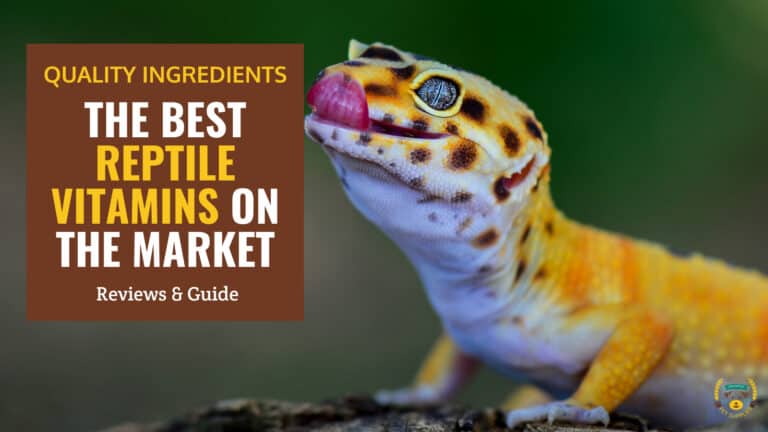


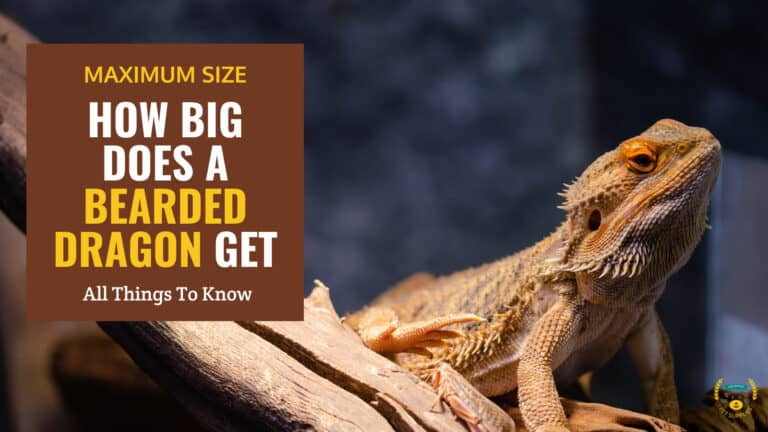
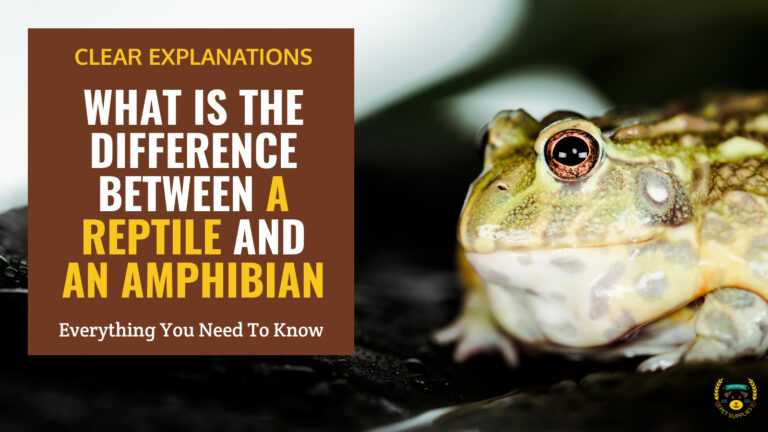
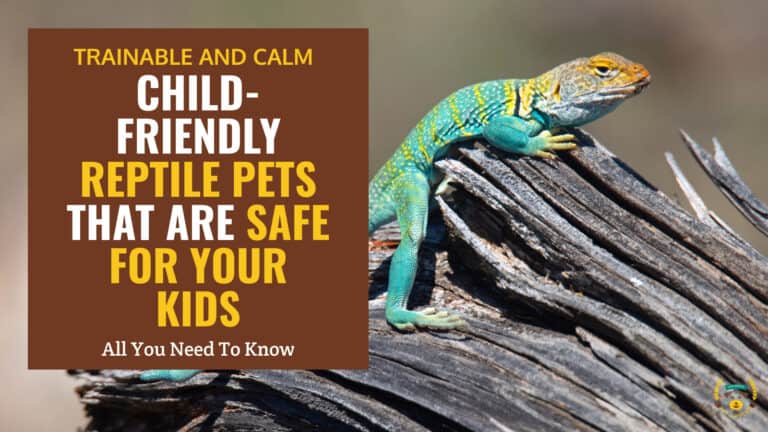
It's interesting to know that young pythons would be challenging since they can be aggressive at first, but they will trust you in the long run. I guess it is best to have a hatchling first if my husband is looking for ball pythons for sale. It would give him enough time to gain its trust without getting injuries that might be major.